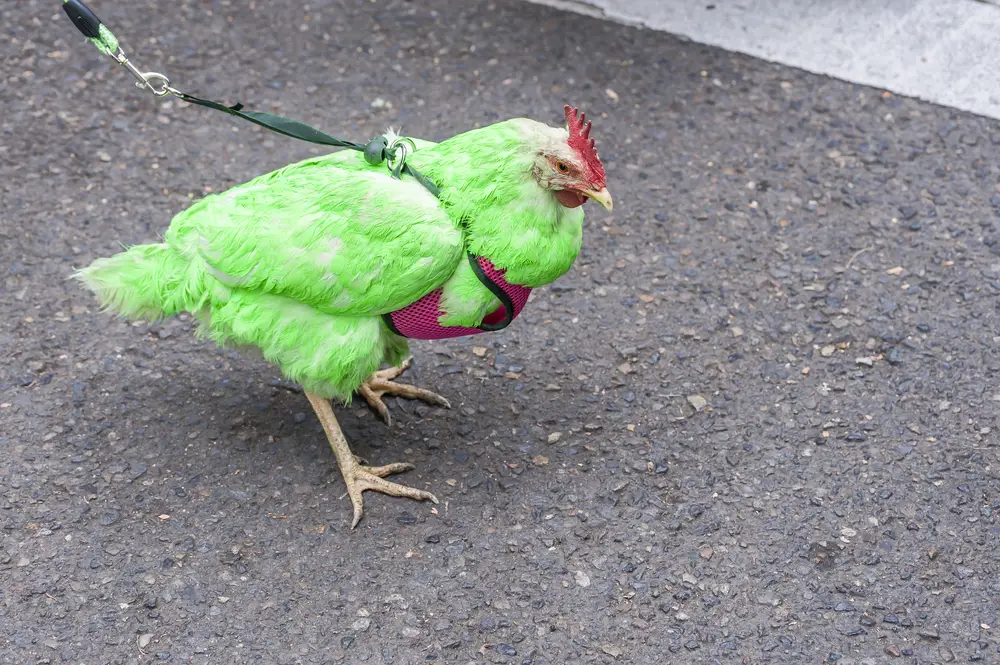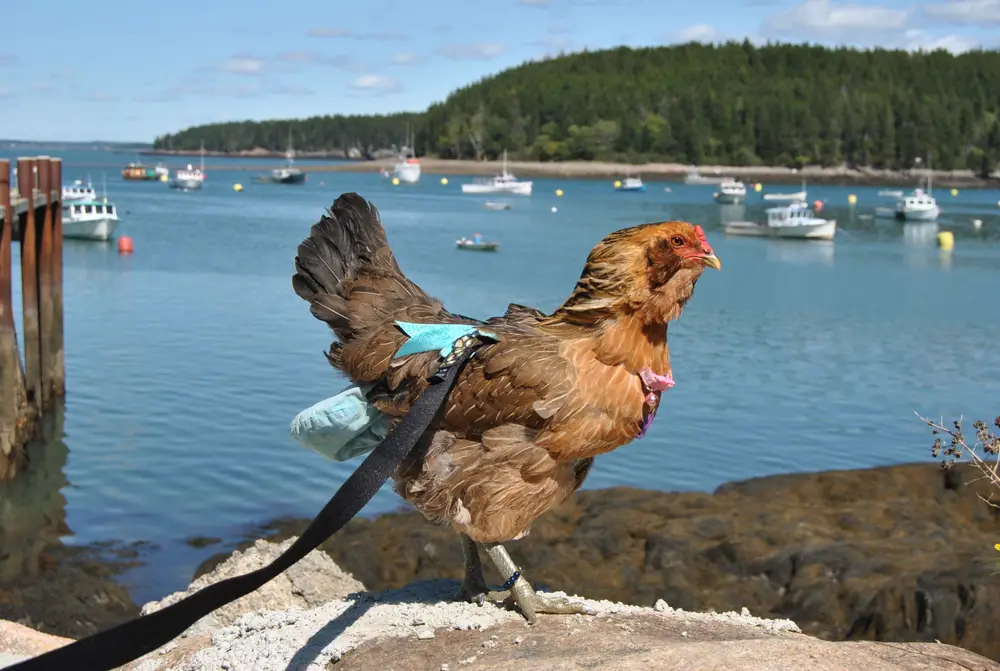A chicken harness is used - literally - for walking your chicken outdoors. Unlike a dog, it will take training and adequate time for your chicken to get used to wearing a harness and being walked on a leash.
The idea that you can walk a chicken with a harness may sound strange. However, chickens can tolerate harnesses with a proper introduction and training period.
The question remains – why would you want to walk your chicken? If you live in an area with predators and it isn’t safe to allow them free-range, a chicken harness can provide that freedom and allow your chickens to get exercise and forage.
Some people also train chickens to be therapy animals and chicken harnesses allow for them to go into places like nursing home facilities where they provide companionship for the elderly.
Of course, you may just want to take your pet chicken with you to the pet store, or show them off walking around your neighborhood!
In this article, we will cover the types of chicken harnesses that are available, how to find the right harness for your backyard chicken, and how to introduce your birds to wearing and using a harness safely and effectively.
Table of Contents
What Types of Chicken Harnesses Are There?
A chicken harness is made to fit over your chicken’s head and around, and beneath their wings and is worn the same as a pet vest or pet harness for any other type of animal. If you’ve ever seen a dog harness, it looks and functions similarly.
Chicken harnesses are most often made of a breathable mesh-like fabric, which is washable and easy to air dry. The harnesses usually come as part of a leash set, including a six-foot-long chicken leash.
Most chicken harnesses come in one of five different colors: purple, pink, blue, red, and black.
What Size Harness Should You Get for Your Chicken?
Chicken harnesses come in different sizes:
- Bantam (small size)
- Standard
- Large size (rooster size)
You will want to check the weight and size of your chicken and compare to size charts of the supplier to get the right size.

There are also some adjustable harnesses that may be good to purchase if your chicken doesn’t fit into any of the three pre-set sizes that are typically available.
Your chicken harness hen size is key here. You don’t want to be taking a lovely walk with your favorite hen, and have her escape as you’re crossing the road!
You want to ensure that your harness is fairly heavy-duty and has secure clips and fasteners. Inspect the sewing on the harness and ensure there are no loose threads that indicate poor workmanship when you purchase your harness.
Where can You Buy a Chicken Harness?
There are different retailers that sell chicken harnesses:
- Amazon
- eBay
- Chicken breeders
- Pet stores
- Used marketplaces (Facebook, Craigslist)
How cute are these bow ties at the front of their harnesses?! Valhoma and Lansinger also make beautiful, well-made harnesses.
When deciding which harness to purchase, check out their return policy, customer reviews and star ratings to ensure you’re getting a harness that other people have had a good experience with. Just like a dog harness, quality is key.
How to Introduce your Chicken to a Chicken Harness.
When it comes to training, most people recommend starting your chicken with a chicken saddle, rather than the harness. Aim to start at a younger age so they get used to wearing something, and will be more likely to cooperate.
A chicken saddle is something that a hen will wear to protect her back from injuries when a young or aggressive rooster is treading during mating. Chicken saddles are not as constricting as a harness, so they are easier to put on.
It’s best to fit the chicken saddle at night, and to allow your chicken to get used to it for a few days before introducing the chicken harness.
Some chickens will be tolerant of a chicken saddle, and for others, it may take some time before they are comfortable wearing it.
Allow your chicken to go at a pace that is comfortable for them – otherwise, they will fight you when you attempt to put on the harness by lowering their neck, making it virtually impossible to get it on.
Once you have successfully put a chicken harness on your chicken, ensure that you don’t try to add a chicken leash right away – give them some time to get used to this new contraption.
Also, do not leave a harness on at night because it is possible for your chicken to get injured in the chicken coop by the numerous clips on the harness. It’s easy for a chicken to get caught on a roost or perch!
When your chicken has had some time to get used to the harness, you can try to attach your chicken leash with a D-ring. Allow your chicken to “lead” and do not try to pull or force your chicken to go where you want it to go.
Once your chicken has accepted the leash, you can then try to gently lead her where you want her to go – it is advisable to offer treats along the way when she is compliant. Chickens are smart – so if they know they will get tasty tidbits, they are more likely to accept being walked.
Remember, some chickens will accept a chicken harness readily, while others may not. Go at a slow pace, and have realistic expectations – before you know it, you’ll be strutting your stuff alongside your chicken.

